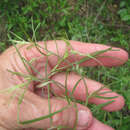Comprehensive Description
provided by North American Flora
Psoralidium linearifolium (T. & G.) Rydberg
Psoralea Unearifolia T. & G. Fl. N. Am 1 : 300. 1838.
Psoralea Uneanfulia robusla Coult. Contr U. S. Nat. Herb. 1. 34. 1H9U.
Lotodes linearifolium Kuntze, Rev. Gen. 194. 1891.
A perennial, with a creeping rootstock; stem 3-8 dm. high, sparingly glandular-dotted sparingly strigose or glabrate, striate, with long slender branches; leaves digitately 3-foholate or those of the branches 1-foliolate; stipules lanceolate or subulate, 3-7 mm. long; petioles 1-5 mm. long; leaflets linear, 2-6 cm. long, 1-3 mm. wide, with numerous small glands, glabrous above, sparingly strigose beneath, acute at both ends; peduncles 4-8 cm. long; racemes lax, few-flowered, 3-6 cm. long; flowers 1-4 at each node; bracts lanceolate, acuminate; pedicels 4-8 mm. long; calyx 3-4 mm. long, conspicuously punctate, sparingly strigose; lobes lanceolate, acute, as long as the tube; corolla blue, 7-8 mm. long; banner rounded-obovate ; pod 8 mm. long, ovoid, flattened, gradually tapering into a straight beak; seed dark-brown, broadly obliquely reniform.
Type locality: Arkansas.
Distribution: Western Nebraska and eastern Wyoming to Arkansas and Texas
- bibliographic citation
- Per Axel Rydberg. 1919. (ROSALES); FABACEAE; PSORALEAE. North American flora. vol 24(1). New York Botanical Garden, New York, NY
Physical Description
provided by USDA PLANTS text
Perennial, Herbs, Stems woody below, or from woody crown or caudex, Plants with rhizomes or suckers, Taproot present, Nodules present, Stems erect or ascending, Stems less than 1 m tall, Plants gland-dotted or with gland-tipped hairs, Stems solid, Stems or young twigs glabrous or sparsely glabrate, Stems or young twigs sparsely to densely hairy, Leaves alternate, Leaves petiolate, Stipules conspicuous, Stipules green, triangulate to lanceolate or foliaceous, Stipules setiform, subulate or acicular, Stipules persistent, Stipules free, Leaves compound, Leaves palmately 2-3 foliate, Leaf or leaflet margins entire, Leaflets 3, Leaves glandular punctate or gland-dotted, Leaves hairy on one or both surfaces, Inflorescences racemes, Inflorescences spikes or spike-like, Inflorescence axillary, Bracts conspicuously present, Bracts hairy, Flowers zygomorphic, Calyx 5-lobed, Calyx gland-dotted or with glandular spot, Calyx gibbous, inflated, or spurred, Calyx hairy, Petals separate, Corolla papilionaceous, Petals clawed, Petals blue, lavander to purple, or violet, Banner peta l ovoid or obovate, Banner petal auriculate, Wing petals narrow, oblanceolate to oblong, Wing petals auriculate, Wing tips obtuse or rounded, Keel tips obtuse or rounded, not beaked, Stamens 9-10, Stamens diadelphous, 9 united, 1 free, Filaments glabrous, Style terete, Style hairy, Fruit a legume, Fruit unilocular, Fruit freely dehiscent, Fruit oblong or ellipsoidal, Fruit exserted from calyx, Fruit enclosed in calyx, Fruit beaked, Fruit glabrous or glabrate, Fruit gland-dotted or with gland-tipped hairs, Fruit 1-seeded, Seeds ovoid to rounded in outline, Seed surface smooth, Seeds olive, brown, or black.

